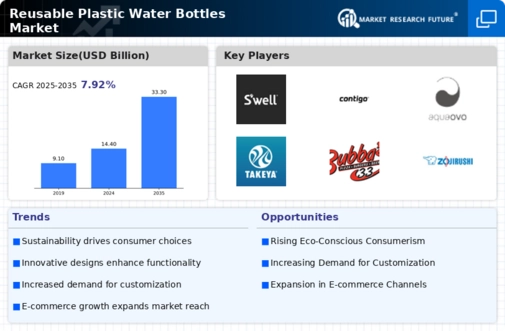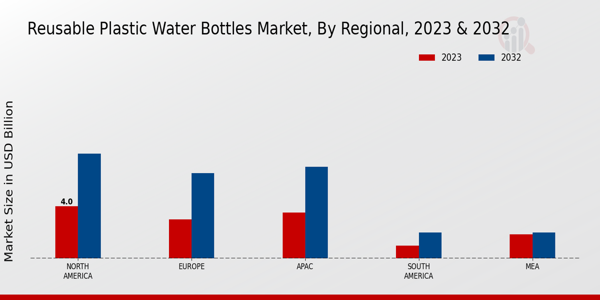Market Growth Projections
The Global Reusable Plastic Water Bottles Market Industry is poised for substantial growth, with projections indicating a market size of 14.4 USD Billion in 2024 and an anticipated increase to 33.3 USD Billion by 2035. This growth trajectory suggests a compound annual growth rate of 7.92% from 2025 to 2035. Such figures reflect the rising consumer preference for sustainable and reusable products, driven by environmental awareness and health considerations. As the market evolves, it is likely to attract new entrants and innovations, further enhancing its competitive landscape. The future of the industry appears promising, with numerous opportunities for growth and development.
Health and Safety Concerns
Health and safety considerations are increasingly influencing consumer choices in the Global Reusable Plastic Water Bottles Market Industry. Many individuals are opting for reusable bottles made from BPA-free plastics, which are believed to be safer than traditional plastic containers. This shift is driven by concerns regarding chemical leaching and its potential health impacts. As consumers prioritize their well-being, the demand for high-quality, safe reusable water bottles is expected to rise. This trend may contribute to the market's growth, with projections suggesting a compound annual growth rate of 7.92% from 2025 to 2035, indicating a robust future for the industry.
Growing Environmental Awareness
The increasing global consciousness regarding environmental sustainability appears to drive the Global Reusable Plastic Water Bottles Market Industry. Consumers are becoming more aware of the detrimental effects of single-use plastics on ecosystems. This awareness is prompting a shift towards reusable alternatives, such as plastic water bottles, which are perceived as more eco-friendly. As a result, the market is projected to reach 14.4 USD Billion in 2024, reflecting a growing preference for sustainable products. Governments worldwide are also implementing regulations to reduce plastic waste, further supporting the demand for reusable options. This trend indicates a potential long-term growth trajectory for the industry.
Rising Demand from Outdoor Activities
The surge in outdoor recreational activities is significantly impacting the Global Reusable Plastic Water Bottles Market Industry. As more individuals engage in hiking, camping, and fitness activities, the need for portable hydration solutions is increasing. Reusable plastic water bottles are becoming essential gear for outdoor enthusiasts, providing convenience and sustainability. This trend is reflected in the market's projected growth, with estimates indicating a rise to 33.3 USD Billion by 2035. The outdoor lifestyle trend is likely to continue driving demand, as consumers seek products that align with their active lifestyles while minimizing environmental impact.
Government Regulations and Initiatives
Government regulations aimed at reducing plastic waste are influencing the Global Reusable Plastic Water Bottles Market Industry. Many countries are enacting policies that encourage the use of reusable products and discourage single-use plastics. These initiatives may include bans on plastic bags and straws, as well as incentives for manufacturers producing sustainable alternatives. Such regulatory frameworks are likely to create a favorable environment for the growth of the reusable plastic water bottle market. As these policies gain traction globally, they could significantly contribute to the industry's expansion, aligning with the increasing consumer demand for environmentally responsible products.
Technological Advancements in Materials
Innovations in materials technology are playing a crucial role in shaping the Global Reusable Plastic Water Bottles Market Industry. The development of advanced plastics that are lighter, more durable, and easier to clean is enhancing the appeal of reusable bottles. For instance, the introduction of Tritan and other high-performance plastics has improved the functionality and aesthetic appeal of these products. As manufacturers continue to innovate, the market is likely to benefit from enhanced product offerings that cater to diverse consumer preferences. This evolution in materials technology could further bolster the industry's growth, as consumers seek out superior alternatives to traditional plastic bottles.
















